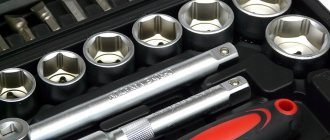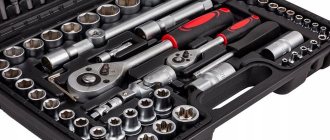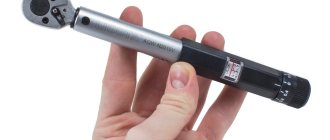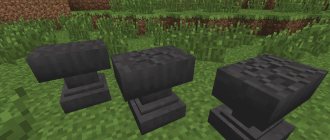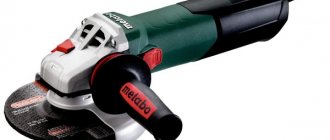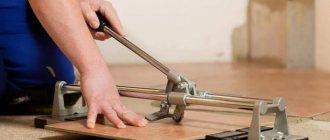A huge number of car repair shops and tire shops in every locality in Russia have almost completely eliminated the need for car enthusiasts to tinker with their own cars, eliminating faults.
However, there are often situations when on a deserted road there is an urgent need to replace a tire with a spare tire, and a road kit with a minimum number of tools comes in very handy here. Every prudent driver must have a torque wrench in his kit of essentials.
Key device
Working principle of a torque wrench
Many novice car enthusiasts often ask the question - how to use a torque wrench? This device is a universal tool designed to use various nut sockets, as well as internal hexagon sockets for loosening or tightening automotive fasteners. The key has a very simple design, and almost every car enthusiast can learn how to use it.
The main element of a metric wrench is a set of removable working parts - ratchets, which are put on a square adapter and matched to the size of the nut.
Next in the product there is a high-strength element that affects the entire operation of the tool - a square rod made of hardened steel, on which all the working attachments in the set are installed.
All elements of the key are enclosed in a durable steel case, and it can be coated with a rubber coating to prevent the tool from slipping in the hand. A spring block is hidden inside the key, allowing the car owner to adjust the force.
Note!
So that the master can see exactly what force he is exerting on the fastener, the wrench must have a dynamometer or at least a measuring scale, either with an arrow or electronic, in the form of an LCD display.
There is a special plastic clamp on the edge of the nozzle, which allows you to fix the required force and not tear off the nut.
Indicator key
Important!
To remove and install the wheel, significant force must be applied, so the reach of the wrench handle must be at least 30 cm, and the tool itself must be made of high-quality steel to prevent deformation or breakage of the tool.
conclusions
Of course, each car owner must determine for himself which one to choose and whether it is needed at all for the specific conditions of use of the vehicle. In addition, professional use of wrenches requires many additional accessories: sockets, adapters, cardan couplings, adapters. The pleasure of having a complete set of torque tools will cost the car owner a decent amount. However, for a small vehicle repair business it is impossible to do without it.
Because we have never encountered such a tool. Why are such devices needed? In what types of work are they used? Let's try to answer the questions presented.
Types of torque wrenches
Keys can be of several types depending on the principle of operation, the design of the spring mechanism, quality, manufacturer and cost of the product. All keys can be divided into the following main categories:
- Indicator or pointer type - they contain a dynamometer with a pointer dial on the body, which is very simple for determining force, and this instrument has a relatively low cost because it does not contain complex digital devices. The device also has a minus - when determining the force, it gives an error of up to 6-8% of the exact readings.
- With an electronic indicator , the operating principle and design of the device are almost the same, except that the digital round scale is replaced by an electronic display. The device provides more accurate measurements, and the total error does not exceed 1%, but at the same time it is more expensive and can quickly break if dropped.
- Click type. This instrument has a graduated handle with a slider and is adjusted with a slight hand effort, each of which produces a characteristic sound. The error of this device does not exceed 4%, which is much lower than that of an indicator key, but greater than when using an electronic product. In terms of price, this key is in the middle range and is the most popular.
You may be interested in this About hydraulic jacks for cars and trucks
Electronic key
Important!
When choosing a key, the car owner or mechanic needs to know for what purpose he needs it. Tire service technicians do not need to know too precise force, unlike mechanics at service stations who deal with vehicle hydraulics or repair of electronic systems.
Tool selection
All types have their pros and cons. Yes, and working with them is different. Therefore, if you are used to tightening with a switch, and then suddenly you come across an electronic one, you won’t be able to act on a similar principle.
As for the manufacturer itself, you should look for a key from the range of the following brands:
- Bison;
- King;
- JTC;
- Force;
- Jonnesway;
- Ombra;
- Licota;
- Autodelo.
In many cities, such as Moscow, St. Petersburg, Yekaterinburg or Volgograd, for example, you can easily find any of them. If necessary, order a whole set.
The choice depends on how much error is allowed during the tightening process. If a part needs to be tightened as accurately as possible, a pointer DMK is capable of tightening, for example.
How to use a click and other type of torque wrench
To use the tool correctly, the car enthusiast does not need any special skills; it is enough to just tighten or unscrew the nut 2-3 times. For each product of proper quality there is an instruction manual for using the device, in accordance with which the following steps must be followed:
- Select a suitable nozzle that will match the size of the nut.
- The required maximum force that needs to be applied to the fastener is built on the handle.
- After setting the scale, it is necessary to fix the screw, which will determine this force and prevent the master from tearing off the nut.
- The working body of the wrench is placed on the nut and tightened. The car enthusiast does not have to worry about breaking the fasteners, since when the set force is reached, the device will begin to crack and turn idle.
Important!
If the nuts are especially sensitive to excess force, then it is advisable to set the force limit on the scale to a slightly lower force limit than the fastener can withstand, because a measurement error can cause material failure.
Snap key
First meeting
With the current assortment, buying torque wrenches is not a problem. Although in some cases renting will be a more rational solution. But more on that later.
For a car, its repair and maintenance, a torque wrench (DMW) is often used. This is a tool designed for tightening a threaded connection when you need to adhere to a certain tightening torque. In simple terms, torque is force or force. The units of measurement are Nm or kg.
DMK is required in order to adhere to the technical recommendations of the vehicle manufacturer, where some components are tightened with a certain force. An open-end wrench will not always cope with its task.
If you under-tighten or over-tighten an element, there is a risk of breakage, stripping of threads, or falling off of the parts themselves that hold the fasteners. You need to initially set the required force with which the tightening will occur. This is where a torque wrench comes in handy.
Varieties
In the photo you can see what keys exist. But purely by appearance it is difficult to understand who is who and what is the difference between them.
Maximum torque for bolt tightening
In order to properly tighten car bolts and nuts without damaging them, the technician must be aware of the maximum forces depending on the length, diameters of the elements, and the quality of the steel from which they are made. These data on the maximum torque are shown in the table.
| Thread/pitch, mm | Strength class 4.6 | Strength class 5.8 | Strength class 8.8 | Strength class 10.9 | Strength class 12.9 |
| 5/0,8 | 2,1 | 3,5 | 5,5 | 7,8 | 9,3 |
| 6/1,0 | 3,6 | 5,9 | 9,4 | 13,4 | 16,3 |
| 8/1,25 | 8,5 | 14,4 | 23,0 | 31,7 | 38,4 |
| 10/1,5 | 16,3 | 27,8 | 45,1 | 62,4 | 75,8 |
| 12/1,75 | 28,8 | 49,0 | 77,8 | 109,4 | 130,6 |
| 14/2,0 | 46,1 | 76,8 | 122,9 | 173,8 | 208,3 |
| 16/2,0 | 71,0 | 118,1 | 189,1 | 265,9 | 319,7 |
| 18/2,5 | 98,9 | 165,1 | 264,0 | 370,6 | 444,5 |
| 20/2,5 | 138,2 | 230,4 | 369,6 | 519,4 | 623,0 |
| 22/2,5 | 186,2 | 311,0 | 497,3 | 698,9 | 839,0 |
| 24/3,0 | 239,0 | 399,4 | 638,4 | 897,6 | 1075,2 |
| 27/3,0 | 345,6 | 576,0 | 922,6 | 1296,0 | 1555,2 |
| 30/3,5 | 472,3 | 786,2 | 1257,6 | 1766,4 | 2121,6 |
| 33/3,5 | 636,5 | 1056,0 | 1699,2 | 2380,8 | 2860,8 |
| 36/4,0 | 820,8 | 1363,2 | 2188,8 | 3081,6 | 3696,0 |
| 39/4,0 | 1056,0 | 1756,8 | … | 3955,2 | 4742,4 |
This will be interesting to you About Zubr jacks: features of hydraulic bottle devices
To determine the force required for tightening, you need to measure the bolt with a caliper, determining the thread length and diameter, and look at the steel grade on the head. After that, based on certain parameters, you just need to find the corresponding number in the table.
As a rule, the instrument scale is graduated in Nm, but sometimes you can see force indicators in kilograms on it.
Torque wrench included with sockets
Towbars Trailer: buy, install, certificate, reviews
Pay attention to the quality of the materials from which the torque wrench is made. Especially if we are talking about the arrow type. There are no restrictions on force, because when you overdo it, a tool made of poor material will simply break.
Another important selection criterion is the range of effort you need. Among all, the most common is 5-25 Nm. The range depends on the size of the socket wrench head itself.
Rules for correct key use
To ensure that the torque wrench lasts a long time and does not break, service station technicians give various advice to their clients. Basic recommendations for the safe use of this tool are given below:
- It is not recommended to use this expensive product as a wheel wrench or ratchet, unscrewing and tightening all types of nuts or bolts with it, because it is only a measuring tool and the device can quickly fail because its spring mechanism breaks.
- All union or hexagonal nozzles should only be shockless, since any rough shocks will lead to an increase in the error of the measuring scale.
- Only one standard attachment installed on the device can accurately transmit the required torque to the fastener, based on the product of the force and leverage inherent in the dynamometer. If you use any adapters, flexible or rigid extension cords, the indicator on the device will differ greatly from the actual force.
- The use of a homemade lever, for example, cutting a pipe, is strictly prohibited. Excessive force on the ratchet will lead to breakage of the spring mechanism and rapid wear of the device. It is allowed to exert force on the fastener only with the help of the existing shoulder on the handle.
- One of the main principles of operating a device is to treat it with care. Under no circumstances should it be thrown or impacted on the handle, as the dial will certainly be knocked off.
- A torque wrench just purchased from a store cannot immediately be used for its intended purpose. Before the first tightening of a real bolt with a wrench, you need to work several times with idle loading, that is, give the tool the minimum value on the scale and turn it 5-7 times until the characteristic ratcheting sound occurs.
- This tool consists almost entirely of moving metal parts, and long-term storage without use in damp conditions will inevitably lead to corrosion. To prevent this from happening, it should always be put in a cool, dry place, if stored for a long time without use, regularly lubricated with machine oil, and before new use, set up for operation.
- It is mandatory to set the scale to zero after use. This is due to the fact that at any value different from the initial value, the spring mechanism is always under tension, which is why the durable metal of the spring can quickly “get tired” and the reading error will increase significantly.
You may be interested in this About the compressor for inflating wheels
There are no eternal mechanisms, and sooner or later the spring undergoes plastic deformation, which requires its repair or replacement. This procedure is performed at any point in the repair of an automotive instrument and is called instrument verification. So, after this procedure, its accuracy increases to its original values.
Service station
Rare use of the device leads to its damage, so you should not necessarily buy it. For one-time use, it is always beneficial to rent or go to a service station, where there are auto professionals who set up the tool for work every day.
A torque wrench is still a professional device, and it is not at all necessary to have one in the tools of every car enthusiast. In addition, we must remember that an electronic device is always more sensitive than a mechanical one, so it can be used not only when repairing a car, but also during the operation of electronic devices or other high-precision equipment.
Step-by-step operating instructions for tightening the cylinder head
To perform this important operation, when assembling the cylinder block and head, you need to select the type of tool and prepare: a special torque wrench, a ratchet, a socket head, and some motor oil (clean).
It is recommended to adhere to the following order:
- Study the repair and operation manual for this car and determine in what order and with what force (torque) the cylinder head should be tightened;
- Lubricate the mounting bolts with engine oil;
- Insert the bolts into the technological holes and tighten them by hand;
- Set the maximum force level on the dynamometer in accordance with the vehicle repair manual;
- During the first approach, tighten the bolts of the threaded connection, from the middle and further according to the diagram, without bringing the force to the maximum;
- At the final stage, each bolt must be tightened “until it clicks” with a torque wrench. A good example can be seen in the video.
Source: zamena-podshipnikov.ru


